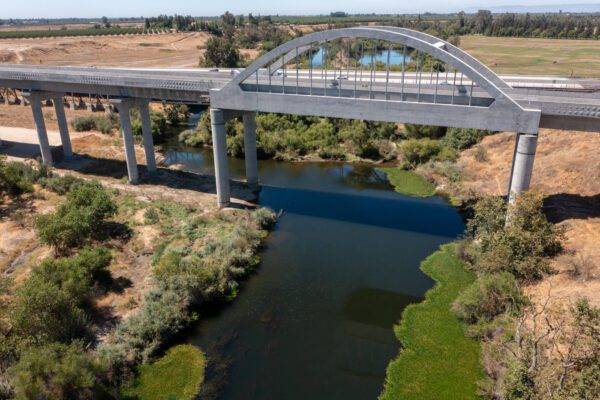Statewide — As of May 31, the most recent data from the California High-Speed Rail Authority shows that 47 African American-owned firms are participating in the project as Disadvantaged Business Enterprises (DBEs).
A total of 936 Certified Small businesses are working on the high-speed rail program statewide, representatives of the high-speed rail project say.
The number of Black-owned DBE firms (5.2%) accounts for $96 million of the $1.136 billion allocated to minority firms thus far.
Sen. Lola Smallwood-Cuevas (D-Los Angeles), a member of the California Legislative Black Caucus (CLBC) and Chair of the Senate Committee on Labor, Public Employment and Retirement says the rail project is “is exactly the kind of investment” California needs.
Smallwood-Cuevas, speaking in Aug. 25 at the State Capitol Swing Space Annex — along with a coalition of Democratic state legislators and union leaders — provided an update on the California High-Speed Rail project and its efforts to employ people from the Black community and businesses.
“It builds a cleaner, more connected California while creating thousands of union jobs,” said Smallwood-Cuevas. “And we must ensure workforce equity, with pathways that open doors for workers who too often have been left out of good-paying careers.”
The remaining DBE minority-owned firms received the following amounts:
- Asian Subcontinent: 24 firms received approximately $65 million
- Asian-Pacific Islander: 52 firms received approximately $86 million
- Native American: 6 firms received approximately $39 million
- Hispanic/Latino: an unspecified number of DBE businesses received approximately $848 million
There are currently 328 certified DBEs participating in the project, according to the California High Speed Authority. The multi-billion-dollar project is billed to be committed to small, disabled, disadvantaged, and diverse businesses playing a major role in building the statewide high-speed rail project.
“As a Central Valley native, I know firsthand how transformative high-speed rail will be for our communities,” stated Assemblymember Lori D. Wilson (D-Suisun City) a member of the CLBC and Chair of the Assembly Transportation Committee.
“Stable and sustained funding is essential to delivering this project and fulfilling the promise made to voters.”
Wilson continued, “Together, these measures not only move us closer to a clean, fast, and safe 21st-century transportation system but also continue to create good-paying union jobs, support small businesses, and drive economic growth across California.”
The news conference was hosted by Senate Transportation Chair, Sen. Dave Cortese (D-San Jose), who was promoting Senate Bill (SB) 545. He and the California High-Speed Rail Authority (CHSRA) urged the Legislature to commit to a steady, annual investment from a cap-and-trade program to fund the high-speed rail project.
Dr. Melanie Okoro, the Principal and Chief Executive Officer of Eco-Alpha, attended the briefing. Eco-Alpha is a Sacramento-headquartered small, women-owned, minority-certified firm that provides environmental, engineering, and facilities support services nationwide. It was established in 2013 and has projects throughout the state.
The company, not classified as a DBE, earned its status as a certified small business and a certified women-minority small business through the California Public Utilities Commission (CPUC) and the Department of General Services (DGS). The certification allowed Eco-Alpha to be featured by CHSRA as a small business working on the project.
The Black-owned firm provides engineering and environmental services to the California High-Speed Rail project, primarily focused on facilities operation and Maintenance. This includes conducting cost estimations for train platforms and maintenance facilities and developing staffing and cost-savings strategies.
SB 545 was held in the Assembly Appropriations suspense file on Aug. 29, effectively killing the measure for this current legislative session. The bill, which aimed to study economic opportunities along the high-speed rail corridor, died after passing the Senate earlier in the year.
As of August, the project has created more than 15,600 jobs — mostly filled by Central Valley residents since construction began on the 171-mile venture. According to a report by CHSRA, up to 1,700 workers report to high-speed rail construction sites each day.
Despite the state’s best efforts since the project started 10 years ago and expectation to be finished in the late 2030s, some lawmakers have balked at the plan, including State Sen. Tony Strickland (R-Huntington Beach).
The initial cost for the high-speed rail began at $33 billion estimate but has since ballooned to north of $130 billion
“It’s a train to nowhere,” Strickland said.
Data specifying the exact number of Black people working on the California High-Speed Rail project is not publicly available. However, CHSRA states that a significant number of its jobs are filled by residents from disadvantaged communities, which often include communities of color.
Targeting disadvantaged communities, CHSRA has a Community Benefits Agreement with the State Building and Construction Trades Council to provide union jobs to workers from disadvantaged communities, many of which are in the Central Valley, where construction is ongoing.
Following the Civil Rights Act requirements as a recipient of federal grant money, the CHSRA and its contractors are required to comply with Title VI of the Civil Rights Act of 1964 and prevent discrimination.
Joseph Cruz, Executive Director for the Laborers’ International Union of North America (LiUNA!), and Chris Hannan, President of the State Building and Construction Trades Council of California (SBCTC), told California Black Media that the demographics for the project included a cross-section of people of color.
Cruz said the project is “changing lives” with its apprenticeship programs and opportunities for the disadvantaged who would likely be denied jobs in other sectors.
“I can speak on behalf of the laborers that 85% of our membership are people of color,” Cruz said. “Through this type of work, I think we are getting the most value when we’re recruiting second chancers, we’re recruiting folks in the foster care system, and folks who chose college is not an option, and this is one way to a good-paying job.”
Juan Carrillo (D-Palmdale) is the only state Assemblymember on the CHSRA’s Board of Directors, where he provides legislative representation and urban planning expertise to the project. He said the work on the projects represents just about every face in the state.
“If you visit some of these areas (Madera, Fresno, and Kern counties) where high-speed rail work is being done, you will see many people who represent the Black and Brown communities,” Carrillo told CBM.
Okoro said laborers are not the only workers benefiting from the project. Professionals of color in engineering, with specialized knowledge and problem-solving skills to design, build, and maintain a wide array of structures, systems, and products, are looking forward to these “great opportunities.”
“As a means of bridging the gap for small business participation, utilization, and sustainability, high-speed rail has already built the physical bridges connecting communities and thoroughfares across the Central Valley,” Okoro said.
“Small businesses are equally committed to building those bridges for our operations and maintenance firms — including engineers, electricians, and other trades — as well as professional service providers such as right-of-way experts, environmental consultants, planners, and AI technicians,” Okoro shared.





